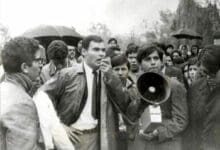From Yiddish to Spanglish: my life as an immigrant
Speaking of Spanglish, Yiddish had a major presence in my childhood. It was the hybrid language spoken by Jews in Eastern Europe during the 18th, 19th, and 20th centuries. It emerged perhaps 1,000 years ago or even more.
Yiddish was the first foreign language I learned, well before English or Hebrew, beginning in 1957 when I was 4 years old and was sent to the Yitzhak Leibush Peretz School on Boulogne-Sur-Mer street in Buenos Aires, Argentina. I returned to Buenos Aires in 2000 after almost 30 years and found the school closed and barricaded. Cement block barriers had been placed to prevent a car bomb attack, and a young policeman told me there were no visitors there.
Although the school is a distant memory, I have retained some words, gestures, traditions and memories of the school’s principal, a kindly elderly woman who waited at the door and kissed each of the school’s 300 students when we left every day. I learned that she died in 2001, a year after my visit.
When a Hebrew word from the Bible is translated into Yiddish, pronunciation changes dramatically. Instead of the Hebrew mazal tov, it’s mazeltov; mishpoche for the Hebrew word for family, mishpacha, shabbes for shabat. Somehow the same Yiddish words sound different in Buenos Aires and Los Angeles. In Argentina, they sound like lunfardo porteño – Buenos Aires slang. Here, like New England English.
Yiddish evolved over the years into an important literary language with well known writers including two Nobel prizewinning authors, Isaac Bashevis Singer and Shmuel Joseph Agnon. Many are familiar with the legendary Yiddish storyteller, Sholem Aleichem, and poets such as Itzhak Katzenelson, murdered in Auschwitz in 1944, Itzik Manger, and Peretz Markish, assassinated by Stalin in 1952.
Here in America many Yiddish words have been incorporated into modern vernacular: chutzpah, meaning audacity or impertinence; bagel, meaning, well, bagel; kvetch, which in Yiddish actually means “compressed,” but which we use as “complain.” Argentine Spanish, on the other hand, has not acquired significant Yiddishisms. Argentine slang always preferred Italian words. Still, a Jew can be called a “Rusito” (little Russian) or a “Moishe“, which is Moses in Yiddish.
Yiddish poetry is exquisite, musical, full of guttural sounds easily of rich, melodic language full of emotional context. Speaking Yiddish or even reading it in public is associated with contortions of one’s entire body, dramatic grimaces and wild gesticulating.
Its expression is compact and intense.
Tzures means the troubles we encounter daily, a shlemazel is an unlucky guy; schlemiel is a simpleton, a bungler. Shayne maydele was my sister Viviana when she was a beautiful young girl. While gurnisht means “nothing,” gurnisht mit gurnisht, literally meaning “nothing with nothing,” is another way to summarize the sad sum total of one’s lifetime efforts.
Yiddish is not connected to any soil, Motherland, country or state, and was almost annihilated by the Nazi Holocaust.
But the establishment of the state of Israel and the declaration of Hebrew as national language was also another blow to the language, and Jewish advancement and integration into various local societies was yet one more. For all purposes, Yiddish is now a dead language, found only among the very religious Orthodox Jews for whom Hebrew is a sacred tongue only to be used for prayer.
But for my grandparents and even my mother, 70 years ago, it was the language used for everyday conversation.
My grandfather Alejandro Kohan, the first journalist in the family, the groiser khokhem (wise man–but not wise guy, which is uber khokhem) worked for the daily Die Presse in Buenos Aires.
He was the zeyde and his wife was the bubbie, but also the baleboste, a single but very descriptive word meaning a “traditional Jewish one, devoted to maintaining a well-run home.”
His mother, who died at 100 years old, was Bubbie Basie (Batia in Hebrew). My grandmother Lerner was Riva, for Rivka in Hebrew and Rebecca everywhere else. All of them and my own mother Ilana (Elena) were and will be forever my Yiddishe Mommas, which, as everybody knows, means much, much more than a Jewish Mother (We will need to ask Sigmund Freud, who had one, for the real meaning.)
Will Spanglish develop into something like Yiddish or is it merely transitional speech which “changes in such a way to approximate the model of local language in a pace that resembles the cultural advance of the speaker” as Argentine writer Ricardo Feierstein says? Or will Spanglish separate itself from English and Spanish so eventually one can SPEAK Spanglish?
Will we see a Spanglish school? (Ilan Stavans has a course devoted to Spanglish).
Rules? A Spanglish Academy?
Scholars recognize six different Yiddish dialects, but when we think of it, we usually refer to Ukranian or Polish Yiddish. In the same way there is a Newyorican Spanglish, the border Spanglish, and more.
Today’s Spanglish is generated by speaking English (or Spanish for some) and combining words from the other language.
Is there a normative Spanglish literature, other than, again, Stavans’ translation of Don Quixote? And, will Los Angeles understand a book in Spanglish from the Bronx?
I don’t know the answers. My work as writer and editor — for my parnusse, to make a living; to have gelt, which means money — leads me to reject the mixture of languages. I speak with my sons in three languages: Hebrew with Ariel, the eldest, Spanish with Uri, English with Mark. All of them mean a lot of nachas, or blessings and pride from the kids (kinderlach), not to be confused with Nachas in Mexican slang.
Back to the subject…
Spanglish develops where people live. Spanglish brings new words from one side of the border to the other. When immigrants return to their pueblos they bring seeds of many new and assimilated words, which germinate, grow, cross-polinate and become part of the fabric of the old language and culture.
Let us recognize Spanglish, examine and play with it. This is required in order to love it.
Like here, in this text, I love Yiddish.











